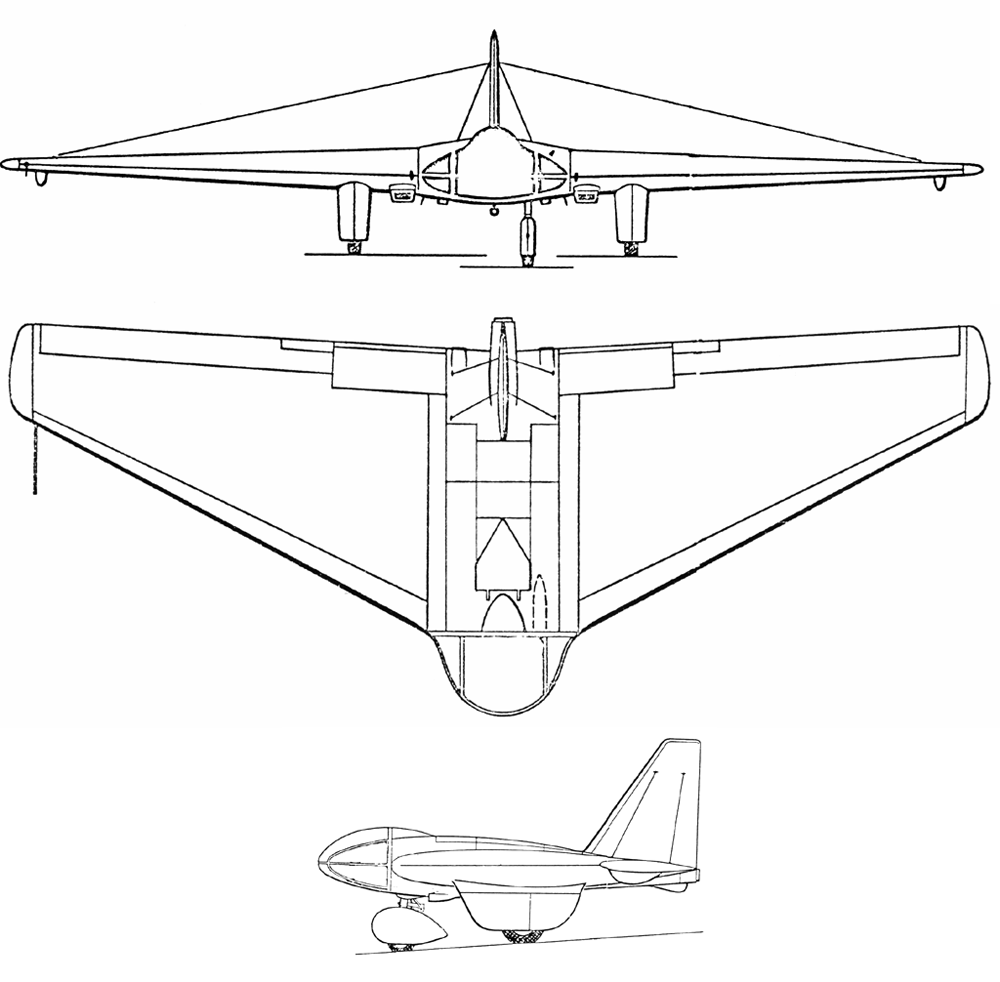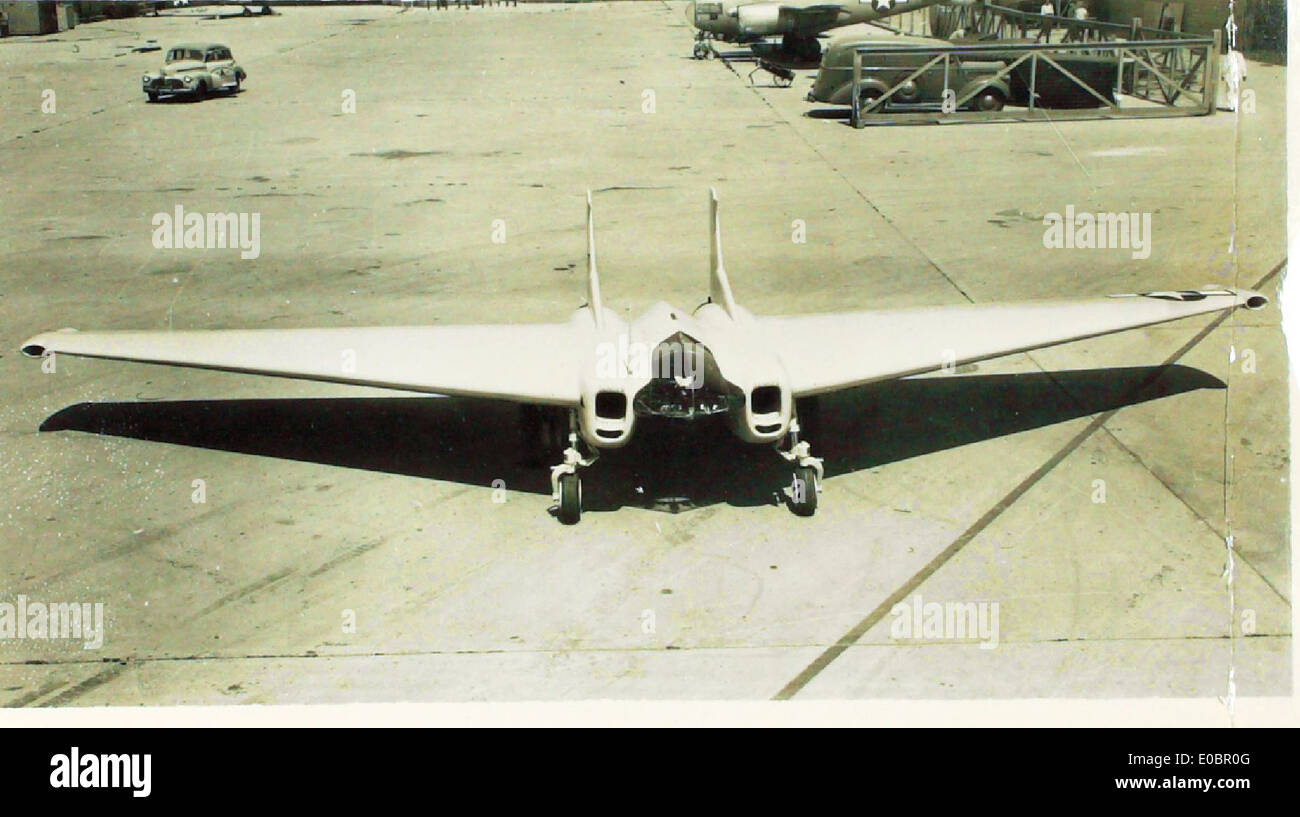Northrop Xp 79 - The Northrop XP-79 Flying Ram was one of the flying wing programs of the US Air Force during World War II. At first it was intended to fly with rocket propulsion, but was later changed to jet propulsion. It is exposed to allow the pilot to withstand high speeds when cornering.
In the year 1942, John K. Northrop developed the XP-79 project, a high-speed winged rocket plane. In January 1943, a contract was awarded to the US Air Force to build three prototypes. Build clean slides first to test radical structures. One of the gliders was a Northrop MX-324. On July 5, 1944, a Lockheed P-38 was towed up and its rocket motor ignited. It was America's first rocket plane.
Northrop Xp 79
It is planned to use an Aerojet XCALR-2000A-1 rocket motor with a thrust of 9 kN. But the fuel made from monoethylaniline and fuming nitric acid was very powerful and poisonous. That's why the plane is made entirely of magnesium alloys. The wing skin is made up of 3mm thick layers and the leading edge is up to 19mm thick and is designed to withstand the effects of impact. The plates are joined using a tungsten inert gas welding technique developed in the United States.
Jack Northrop's Flying Wings Aircraft
However, the rocket motor was not convincing, so two Westinghouse 19B turbojet engines were installed. This new model was designated XP-79B. The first two rocket-powered prototypes were abandoned.
The machine was nicknamed the Flying Sheep because of its wings. The proposed method of combat is very unusual; the machine flies towards enemy aircraft at high speed and destroys them with n wings or m fuselages, the XP-79 should survive these attack tactics due to its high stability.
The first flight made a normal landing on September 12, 1945, after some delays due to a flat tire during landing tests on the Murlok Salt Flats. Fifteen minutes into the flight, the plane went into an uncontrolled roll and pilot Harry Crosby ejected using the single ejection seat. However, Crosby died in the crash because the parachute did not deploy properly.
P-1 • P-2 • P-3 • XP-4 • P-5 • P-6 • XP-7 • XP-8 • XP-9 • XP-10 • P-11 • P-12 • XP- 13 • XP-14 • XP-15 • P-16 • XP-17 • XP-18 • XP-19 • YP-20 • XP-21 • XP-22 • XP-23 • YP-24 • Y1P-25 • P-26 • YP-27 • Y1P-28 • P-29 • P-30 • XP-31 • XP-32 • XP-33 • XP-34 • P-35 • P-36 • YP-37 • P- 38 • P-39 • P-40 • XP-41 • XP-42 • P-43 • P-44 • P-45 • XP-46 • P-47 • XP-48 • XP-49 • XP-50 • P-51 • XP-52 • XP-52 • XP-53 • XP-54 • XP-55 • XP-56 • XP-57 • XP-58 • P-59 • YP-60 • P-61 • XP- 62 • P-63 • P-64 • XP-65 • P-66 • XP-67 • XP-68 • XP-69 • P-70 • XP-71 • XP-72 • XP-73 • P-75 • XP-76 • XP-77 • XP-78 • XP-79 • P-80 • XP-81 • P-82 • XP-83 • X/YP-84
Northrop F 89 Scorpion
Alpha • Beta • Gamma • Lyta • G-21 • G-44 • G-63 • G-72 • G-73 • G-81 • G-164 • Gulfstream I • Gulfstream II
HU-16 • YC-19 • C-100 • UC-103 • YC-125 • JF • J2F • J3F • J4F • JRF • XJR2F • RT • C-1 • C-2 • KC-45
FF • SF • XFT • F2F • F2T • F3F • F4F • XF5F • F6F • F7F • F8F • F9F • XF10F • F11F • XF12F • XP-56 • P-61 • XP-79 • F-89 • F-5 • F-9 • F-11 • F-14 • YF-17 • F-20 • YF-23

Test No. 1 • HL-10 • N-1M • N-3PB • N-9M • Firebird • LEMV • Dark Blue • MX-324 • X-4 • X-21 • X-29 • X-47 • Alien Sonic Boom Showcase • The Nutcracker Northrop XP-79, USAF project number MX-365, is a large Northrop-designed flying-wing fighter design. It has several notable design features; among them, the pilot steers the aircraft from a false position, which allows the pilot to withstand the enormous forces moving up and down relative to the aircraft - and by assembling a magnesium monocoque structure instead of slotted aluminium.
Old Postcard Size Aviation Photo Northrop Xp 79 Aircraft Usa Air Force C1940
In the year 1942, John K. (Jack) Northrop envisioned the XP-79 as a high-speed rocket-powered flying-wing fighter. In January 1943, two prototypes, designated XP-79 (serial numbers 43-52437 and 43-52438), received a contract from the United States Army Air Force (USAAF).
Initially planned to use Aerojet's 2,000 lbf (8,900 N) thrust XCALR-2000A-1 "rotojet" rocket motor, the engine would use monoethylaniline fuel and red fuming nitric acid (RFNA) oxidizer.
However, the rocket engine configuration using a combined rocket-driven turbopump was not satisfactory, and the aircraft was subsequently fitted with two Westinghouse 19B turbojets and designated XP-79B. After the failure of the rocket engine, the first two prototypes were further developed.
To protect the pilot should the aircraft be damaged in combat, the XP-79 has a welded magnesium alloy monocoque with 0.125 inch (3.2 mm) thick trailing edge skin and 0.75 inch (19 mm) rudder skin. edge.
Northrop Xp 79 Flying Ram
The pilot controls the XP-79 via the rudder stock and bottom-mounted runways; wingtip-mounted inserts provide air to the unusual bellows of the high-slotted ailerons.
To test this radical design, Northrop was awarded a contract to build three glider demonstrator aircraft based on the designs of the Air Force Materiel Building Division.
The three gliders were also assigned USAF project numbers, given the Northrop designation NS-12. Confusingly, two project numbers were used, one MX-324 referring to the secretive aspect of the powered glider and the other MX-334 referring to the aircraft built and flown as a pure glider.

The MX-334 is a tailless flying-wing glider similar in layout and structure to the Northrop N-9M. In the late spring of that year, 1943, the completed MX-334 No. 1 was tested in the NACA Langley Wind Tunnel, after which a large steel-wire strut wing was added to ensure directional stability at high speeds. The first flight attempt, a No. 2 towed behind a Cadillac truck, was unsuccessful. After modification, the first launch took place on September 4, 1943, towed by a large truck. For more thorough testing, a Lockheed P-38 Lightning was used to tow the aircraft on its first real flight on October 2, 1943.
Northrop's Mx 324
Early in the year 1944, Aircraft No. 2 was converted to a 2,009 lbf (8,940 N) Aerojet XCAL-200 rocket motor, reverting to the "secret" MX-324 designation. The aircraft is equipped with combined rudder and air brakes on the outboard ailerons. Rocket engine testing began on June 22, 1944, and on July 5, 1944, the Aeroto was launched for powered flight for the first time, becoming the first American-made rocket-powered aircraft.
Flight tests ended on 1 August 1944 with the loss of the remaining two aircraft. MX-334 No. 3 was written off on November 10, 1943, after Harry Crosby lost control of a P-38 tugboat's propellant scrubber during his second flight.
The XP-79B crashed on its maiden flight on September 12, 1945, due to tire brake problems and delays caused by taxi tests on Muroc Dry Lake. Fifteen minutes into the flight, while performing a slow roll, the controllers lost control for unknown reasons. Under the influence of the vertical rotation of the aircraft, the nose drooped and continued to roll. Test pilot Harry Crosby attempted to skydive but was killed by the plane. Soon, the second prototype (43-52438) and the entire project were canceled.
The "secret" designation for the glider version of the MX-334. Powered by a single 200-lbf (890 N) Aerojet XCAL-200 liquid-fuel rocket motor used only on glider No. 2.
A Northrop Yb 35 (s/n 42 38323), Circa In 1947.
This designation is used to describe the pure glide version (including the No. 2 without rocket engines).
Early design of a rocket fighter powered by 2 x 2,000 lbf (8.9 kN) Aerojet XCAL-2000 liquid fuel rocket engines.
Three aircraft were ordered, but only one was completed and crashed on its maiden flight on September 12, 1945.

NOTE: Northrop Corporation names include different technologies. Relevant here only to planes, planes and missiles. Length: 14 ft, Wingspan: 28 ft, Height: 7 ft, Wing Area: 278 sq ft, Empty Weight: 5,840 lbs, Loaded Weight: 8,669 lbs
Northrop P 61 Black Widow
Top Speed: 547 mph, Range: 993 miles, Service Ceiling: 40,000 ft, Rate of Climb: 4,000 ft/min, Wing Load: 31 lb/ft²
Those XP-79 graphics are jaw-dropping! I've never seen anything like it. I've only seen two normal photos in different magazines. It's unbelievable! Great lens. Thank you.
Ah... what color is this thing? The production version should be C.D/N.G, then all natural steel or aluminum painted, but...?
I started thinking about designs that intentionally penetrate enemy aircraft. Am I right? If so, how do you go about tge glass or plexiglass to deal with this? Made of bulletproof glass?
Northrop N 34: Nuclear Powered Project Controlled From A Plane That Is Detachable In Case Of Emergency (design Study)
SkyDiamonds said: I started to think about the design of deliberately drilling into the enemy aircraft. Am I right? If so, how do you go about tge glass or plexiglass to deal with this? Made of bulletproof glass? Click to expand... There is a "striker" at the tip of the wing.
Captain Vic said: So what color is this thing? Yellow...white...what? click to expand...yeah i want to know too
"Essentially, the XP-79 was a low-flying, low-altitude interceptor aircraft. During the first months of the German invasion of Russia in 1941 and 1942, Russian fighter pilots often carried out various raids or air attack techniques.

Northrop, northrop xp 79b, xp 79, northrop dance, lutensol xp 79, xp-79, xp 79 flying ram, northrop xp 79 flying ram, northrop xp-79, northrop xp 56, northrop benefits, northrop corporation
0 Comments